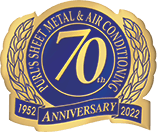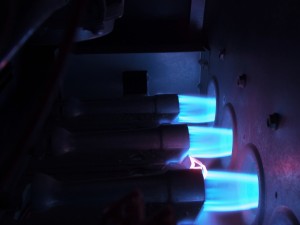You may have heard about furnaces switching to something called electronic ignition. If you have a gas furnace, you might think this doesn’t apply to you—after all, wouldn’t electronic ignition only apply to electric furnaces?
The keyword you might be overlooking is ignition, which means igniting something. Electronic furnaces do not use any type of combustion or burning to work. Instead, they allow electric voltage to flow through a series of heating elements, which then warm up through electrical resistance. The only furnaces that use electronic ignition are the ones that burn natural gas (or less common options like propane or oil).
If you’re curious about how this works and how to light a gas furnace with electronic ignition, we’ll explain below. We’ll also look at why electronic ignition is a beneficial change from standing pilot lights.
How Electronic Ignition Works in a Gas Furnace
For decades, the way furnaces lit the burners when they came on was with a standing pilot light. A single flame in the furnace burned throughout the winter, and when gas started to flow to the burners, this light ignited them to begin the process of heating the air.
Then electronic ignitions systems came along that eliminated the need to have a continually burning pilot light. There are two different types of electronic ignition systems:
- Hot surface ignition: The igniter consists of a heating element made of silicon carbide or a similar material that can withstand high temperatures. When the furnace starts a heating cycle and gas begins to flow to the burners, an electric current runs through the heating element to superheat it. The surface of the heating element becomes hot enough to cause the burners to ignite. Once the burners are lit, the igniter shuts off.
- Intermittent pilot light: As the name indicates, a pilot light still ignites the burners—but it only turns on for a short period. When the heating cycle starts, gas flows to the pilot assembly. An electric spark then ignites the pilot light, which then lights the burners. Once the burners are on, the gas shuts off to the pilot assembly and the pilot light goes out.
Why Electronic Ignition Took Over From Standing Pilot Lights
If you have a gas furnace built within the last ten years, it uses some type of electronic ignition. There are several reasons that furnaces changed to this technology:
- It reduces energy consumption. Having a pilot light burning throughout the winter is a passive use of natural gas that contributes to higher bills. Electronic ignition either uses no extra gas or only uses it briefly.
- It is more consistent and convenient. Have you ever had to deal with a pilot light that kept going out on you in winter and you had to go through the bother of relighting it? Electronic ignition systems can malfunction, but they do so at a far smaller rate than standing pilot lights.
- Electronic ignition is safer than pilot lights. It’s easier for the furnace to detect if the ignition for the gas burners has failed and quickly shut them off.
If you have issues with your furnace’s ignition system, whatever it’s type, you can rely on us for fast repairs.
Call on Purl’s Sheet Metal & Air Conditioning for all your heating needs. Uncompromised Quality & Customer Service Since 1952.


